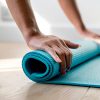The ancient Yogis discovered that the breath provides entry into our very being. The interesting and unique thing about breathing is that it is possible to consciously breath, yet breathing is normally an unconscious act. By controlling the flow of air and focussing awareness on the action of breathing it is possible to access altered states of consciousness.
Imagine: Sit yourself down in a quiet place free from outer distractions, place the body carefully to avoid discomfort. Begin to breath in a rythmic and controlled way focussing awareness on the quality of the breath allow your breath to become smooth and effortless. Gradually lengthening the breath and retaining the inhalation as you hold the awareness fixed and contracted in the core of the somatic field. As the breath moves through the right or left nostril feel the change of density in this somatic field as the breath changes. The hands positioned in mudra take on a special kind of stillness, the legs crossed in any of the seated asana totally relax, the face with eyes closed and no outward expression the senses turn inwards in pratyahara. See how the two halves of the body are passified on inhalation and exhalation until only the diaphragm is moving in a smooth rythmic flow up and down. With retention the awareness moves in the symmetrical midline of sushumna nadi, the pelvic floor gently contracted, the throat seals the dome of the chest with the glottis.
Gradually the mind becomes absorbed in the dance and discursive thinking becomes like a vague echo of the outer world. In a state of total immersion the inner sound emerges in the inner space, inner light appears in the centre of the field of vision, the awareness of the physical form gradually becomes light and dissolves into space.
These three faculties begin to co-mingle in state of synesthesia as the source of consciousess of the self is revealed.The less you try the more you let go the clearer becomes the sense of inner reality. Beyond this it is difficult to explain in words.
“Just As Lions, Elephants And Tigers Are Gradually Controlled So The Prana Is Controlled Through Practice Otherwise The Practitioner Is Destroyed”.Hatha Yoga Pradipika Ch. 2 Sutra: 15.
Pranyama requires subtlety in the midst of a dynamic stress. To practice poorly is in fact dangerous and can damage mental and physiological health. For this reason it is advisable to have an experienced teacher in the initial stages until the practitioner is firmly established in correct practice. Although it is simple to say do not be in a hurry and and dont have any expectations Im sure most people admit that our approach to many things in life is impatient bordering even on violent. Pranayama not only produces a deep abiding calmness but requires it. Like many other aspects of yoga the way is the goal as the goal is the way.
The sanskrit term pranayama refers to the control (ayama) of the life force (prana) and the method for achieving this feat is by controlling the breath. Generally we think of pranayama as a set of breathing exercises but the aim of these exercise is to enter into an experience of the subtle energy that makes up the very core of our being. So we see that pranayama begins with asana but leads to a special state of mind known as dhyana. In fact it is rumoured that Ramana Maharsi practised only a simple Pranayama technique that brought about his profound samadhi.
In the Sadhana Pada (Chapter 2) of Patanjalis’ Yoga Sutra he gives the prerequisite in sutra: 49.
“That (Firm Posture) Being Aqcuired, Inhalation And Exhalation Should Be Controlled. This Is Pranayama.”
The mastery of Asana is said to be firmness in a seated posture for 4 hours yet just 30 minutes is required for initiating pranayama.
“As Its Result The Veil Over The Inner Light Is Destroyed.”
In sutra: 52 he describes the signifyer.
“And The Mind Becomes Fit For Concentration (Dharuna).”
And in Sutra: 53 the result.
The healing capacity of pranayama is perhaps one of the most effective and simplest of the various practices of Hatha Yoga. It is easy to reduce the breath and heart rate and also the speed of the oscillations of the brain with just 10 minutes of practice daily for a few months. By reducing these factors regularly in ones life pranayama can be an aid in healing all those various modern stress related conditions which result in hyperactivity of both nervous and endocrine systems. Pranayama is said to produce a tranquil effect on the mind which lasts ten times longer than from asana alone.
The breathing exercises which prepare the practitioner for the formal practice of pranayama are accessible to all levels. However those more profound practices involving breath retention have a specific prerequisite that one should be able to hold the spine gently erect while sitting unsupported for 30 minutes. The fundamentals tone the muscles of respiration and balance the patterns of breathing. When one has the ability to perform these basic prerequisites formal pranayama using breath retention begins.
The post On Pranayama: appeared first on Noah McKenna.


